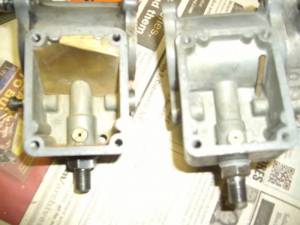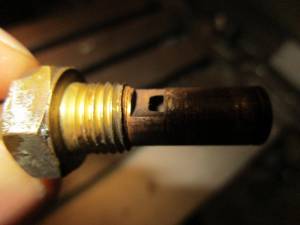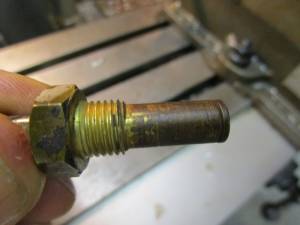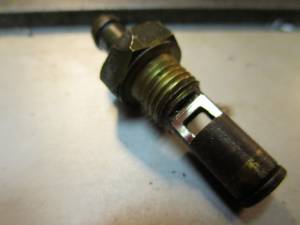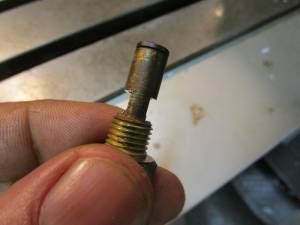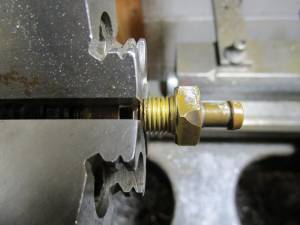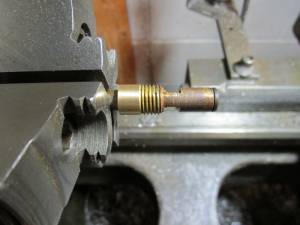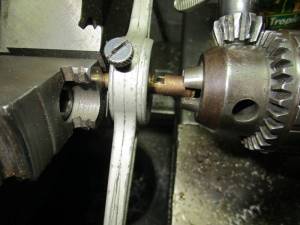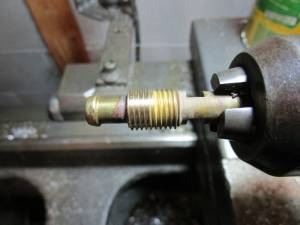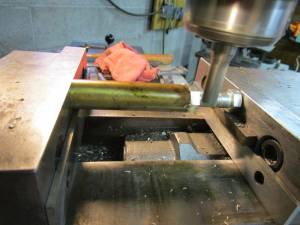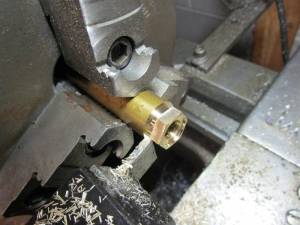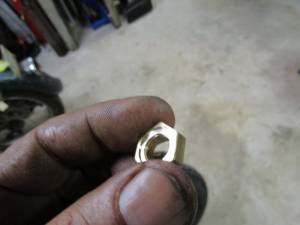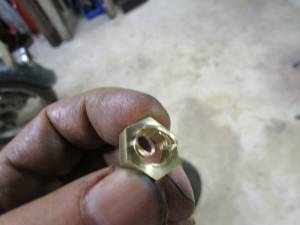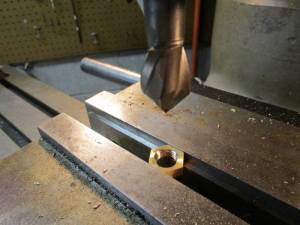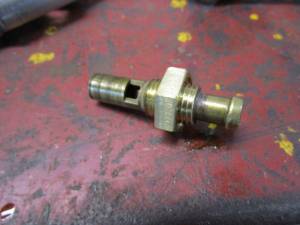Table of Contents
IH: Carburetor, Intake Manifold & Exhaust - Sub-01C
Linkert Carb Functions, Adjustments, Tuning
See also in the Sportsterpedia:
Float Bowl
There is a brass baffle in the DC-7 float bowl on the left in the pic below. The DC-12 (right) does not have one.
The baffle helps arrest an rare-ish annoying Linkert trait.
If your moving at high speed and you grab all the binders you can in order set up for a tight corner; 1)
The fuel sloshes to the front of the bowl opposite of the bowl vent tube.
As you stand the bike back up and peg the throttle (wot), the fuel now sloshes over to the opposite end of the float chamber.
(where it enters the top of the vent tube and exits the carb (spraying the rider, you will smell it).
In extreme cases, if your hanging off the right side of bike, you can get a face full of hi-test.
Needle Seat
Determine if you have DC1 or DC2 inlet seat (these have one “window”).
If so you need to open the second window as the DC6,7,10 and 12 have.
If so, then you can cut a second window in the seat.
You end up with a needle seat position (read as float level) that can be adjusted on the side of the road in seconds.
Thus making the effort required to get this critical aspect of fine tuning quick and easy to dial in.
Tuning
Adjustments per Dr Dick
Adjusting the idle mixture screw critical. 18)
Most will make both adjustments in concert so the bike idles with the least throttle plate opening.
Rarely does this give good manners other than idling in the driveway.
The bigger picture regarding these adjustments - for this the throttle plate must be:
- Positioned (milled notch up & facing air cleaner)
- Registered correctly (even peripheral contact to throttle body at fully closed)
Removing the brass screw plug near idle mix screw exposes the idle well.
On the side wall of the well, you will see a hole that feeds mixture (not fuel) to the idle mix screw.
Mixture that enters this hole is regulated by the adjuster screw and discharged into air the stream thru a hole drilled close to intake manifold.
This supplies most of the idle mixture.
Then on the floor of the well, you will see a series of 4 tiny holes. These are the transition holes.
The remainder of idle mixture comes from the 1st (one closest to manifold) transition hole as it's open to low manifold pressure.
The other 3 are open to the higher atmospheric pressure because they are on the other side of throttle plate at idle.
That means lots of air enters the well thru the 3 hi pressure holes. All that air dilutes the fuel into a 'mixture'.
Because the idle mix screw adjusts the flow of this mixture a funny thing happens as you richen it.
Because the air component is so much less dense than the fuel component, the mix screw is less a restriction to the air than to the fuel.
It gets to a point where opening it adds more air then it does fuel. In other words it will only get so rich no matter how far you back it out.
This is a DC Linkert anomaly because 4 holes spread over a very large throttle plate swing bleed a lot of air into the well on idle.
Things change as soon as you begin opening throttle plate.
Now the number of transition holes open to low pressure is larger and the number open to atmospheric pressure is less (ie: the air component of the mixture drops).
Now the idle mix screw is controlling a more fuel laden mixture.
The ratio of air to fuel continuously drops as you open the throttle until the last holes is on downstream of the plate.
The mix screw will have a larger effect on low throttle running than idling. You need to set the screw where you get good around town manners.
Then adjust the speed screw to the appropriate speed.
This is a delicate balancing act that will change as the properties of the air change: temperature, pressure (altitude or barometer), and water content (humidity).
The DC is prone to this fickleness due to the large air bleed variation at different throttle plate positions.
The S&S carbs based on the DC Linkert used only two transition holes in the early years and three later on.
Both show a marked improvement in weather stability.
Adjusting the Linkert DC
| Carb Idle Speed |
|---|
| Adjust until engine idles and runs smoothly |
- A properly adjusted carburetor requires little re-adjustment according to the FSM. It shouldn't be necessary to change the adjuster of the low speed needle more than 1/8 turn or the high speed adjuster more than 1/4 turn richer or leaner to obtain correct mixture for a change in altitude unless there are some worn or obstructed parts to consider.19)
- Before attempting to correct faulty engine performance through carb adjustment, eliminate all other possible causes for poor engine performance such as bad spark plugs, poor timing, mal-adjusted tappets, dirty air cleaner, leaking gaskets and poor manifold connections.20)
- The fuel/ air mixture for low engine speed is regulated by the low speed needle only. The fuel supply for high speed is regulated by a combination of the adjustable needle and the fixed jet (which dominates the regulation of high speed fuel supply). The high speed needle provides a supplement, to a degree, of the fuel supplied by the fixed jet when it is found that slightly enrichening the mixture improves engine performance. 21)
- The FSM may be of little use from this point on.
- Its trial and error now to find out what works for you. Idle speed is critical in easy starting. Low idle can make bikes difficult to start and too high is uncomfortable at stops. There is a sweet spot in there somewhere that you must find. 1200 rpm is a good speed to begin your fine tuning. 28)
- When it's warm and it's been off for a minute. I only need to push the kicker through and it starts up. If it's been off for a bit, the first kick without retarding the mag results in a locked up kicker, feeling there is a fuel charge sitting in the combustion chamber. The idle adjustment screw can be backed out as far as I want and it doesn't change much at all. If I go too lean, it will stumble of course. If the idle adj. screw is 1/8th out from stumble as the manual suggests, I have a hard time with starting. 29)
- The bigger picture regarding these adjustments for this the throttle plate must be: Positioned (milled notch up & facing air cleaner) and registered (even peripheral contact to throttle body at fully closed) correctly.30)
- Removing the brass screw plug near idle mix screw exposes the idle well. On the side wall of the well you will see a hole that feeds mixture (note that I didn't say fuel) to the idle mix screw. Mixture that enters this hole is regulated by the adjuster screw, and discharged into air stream thru a hole drilled close to intake manifold. This supplies most of the idle mixture.31)
- Then on floor of the well you will see a series of 4 tiny holes. These are the transition holes. The remainder of idle mixture comes from the 1st (one closest to manifold) transition hole as its open to low manifold pressure. The other 3 are open to the higher atmospheric pressure because they are on the other side of throttle plate at idle. That means lots of air enters the well thru the 3 hi pressure holes. All that air dilutes the fuel into a 'mixture'. Because the idle mix screw adjusts the flow of this mixture a funny thing happens as you richen it. Because the air component is so much less dense than the fuel component the mix screw is less a restriction to the air than to the fuel- its gets to a point where opening it adds more air then it does fuel. In other words it will only get so rich no matter how far you back it out. This is a DC Linkert anomaly because 4 holes spread over a very large throttle plate swing bleed a lot of air into the well on idle. Things change as soon as you begin opening throttle plate. Now the number of transition holes open to low pressure is larger and the number open to atmospheric pressure is less. ie: the air component of the mixture drops. Now the idle mix screw is controlling a more fuel laden mixture. The ratio of air to fuel continuously drops as you open the throttle until the last holes is on downstream of the plate. The mix screw will have a larger effect on low throttle running than idling. You need to set screw where you get good around town manners and then adjust the speed screw to the appropriate speed.32)
- This is a delicate balancing act that will change as the properties of the air change: temperature, pressure (altitude or barometer), and water content (humidity). The dc is prone to this fickleness due to the large air bleed variation at different throttle plate positions.33)
- The S&S carbs based on the DC Linkert used only two transition holes in the early years and three later on. Both show a marked improvement in weather stability.34)
- These carbs are extremely touchy to float level at just off idle throttle positions. Problems show as spitting / coughing on one end of the spectrum to burbiling / stumbling at the other end. Many owners will report how precise you need to be with float levels to get your bike to run as a fine watch.These guys also eventually learn two things:35)
- Float levels will rise on their own due to the steel inlet needle wearing the brass seat away. This is a mileage thing– just like tire and chain wear (steel needle carbs only- linkert, orig earlies and orignal L's). 36)
- Secondly and more importantly, these carbs are very susceptible to errant low speed metering as fuel composition, barometric pressure, humidity, and air temperature vary. Trying to hit the sweet spot requires many float adjustments, idle mixture settings, idle speed settings and road tests. To do away with that wasted time and aggravation, I fit all my side bowl carbs with an externally adjustable float level. Now I can change float level on a whim.37)
Links,Parts and Services for Linkert Carbs
| Carb Assembly is HD Part Number: 27155-57B38) | |||
| Model (marked on carb) | Idle Port Hole Drill Sizes | Model (marked on carb) | High Speed Hole Drill Sizes |
|---|---|---|---|
| DC-1, 1L, 1M, 10 DC-2 | #70 (0.028 in) #56 (0.0465 in) | DC-1, 1L, 1M, 10, 6, 7, 12 DC-2 | #55 (0.052 in) #70 (0.028 in) |

